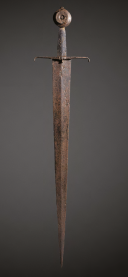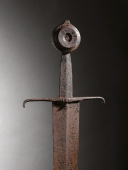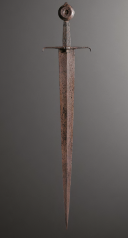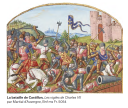
One-handed sword, Europe, possibly Germany, second quarter of the 15th century. Public auction: TENTATION° 3 Thursday, May 22, 2025 - 6 p.m Drouot - room 9: Giquello et associés
Jeudi 22 mai 2025 - 18h
Drouot - salle 9
GIQUELLO
Alexandre Giquello
Violette Stcherbatcheff
Drouot - rooms 9
TENTATION° 3
The "Castillon Group": One-Handed Sword, Three Ball and Chain Maces.
SYMBOL OF ASCENSION TO POWER, WHEN BONAPARTE BECAME FIRST CONSUL, THEN NAPOLEON, the sword that accompanied him from the Consulate to the Hundred Days, offered to Emmanuel de Grouchy, the last Marshal of the Empire.
Thursday, May 22, 2025 - 18pm
exhibitions on Tuesday, May 22 from 11am to 4pm
Wednesday, May 20 from 11am to 6pm
Thursday, May 21 from 11am to 12pm
Phone during the exhibition + 33(0) 1 48 00 20 09
SPÉCIALISTE
Marina Viallon
EXPERT
Bertrand Malvaux, CNES
Estimation : 30.000 : 50.000 euros
LOT 3
One-Handed Sword
Long, triangular iron blade with a double edge and a central ridge, bearing on one side the hollow mark of its blacksmith (a sort of square with arc-shaped edges).
Straight quillons curved towards the blade at their ends, flat on top and keeled underneath. Crosspiece with three moldings whose knobbed tip aligns with the blade edge. Tang tapering at the pommel. Heavy, circular, chamfered pommel hollowed in the center on both sides with a knob at the top.
Europe, possibly Germany (found in the Dordogne), second quarter of the 15th century
Total length 91 cm – Blade length 73.5 cm – Width 18.5 cm
Very good archaeological condition, fairly smooth surface oxidation, blade edge slightly damaged in places, blade very slightly twisted.
Provenance:
- Private French collection
- Inherited in 1988
Bibliography:
- Clive Thomas, Additional Notes on the Swords of Castillon, in London Park Lane Arms Fair, 2012, pp. 40-63
Illustrations published:
— The Battle of Castillon, The Vigils of Charles VII by Martial d'Auvergne, BnF ms Fr. 5054
HISTORY:
The "Castillon Group"
In the early 1970s, a chance discovery during dredging in the Dordogne River revealed a large collection of 15th-century weapons, in excellent condition, probably from a boat that had sunk in the river. Dispersed on the market over the years by its discoverers, the group was previously known only for its exceptional set of swords (probably around a hundred) and a few daggers. This sale now links three exceptional artillery pieces to it. Based on various, sometimes elusive and contradictory, information gathered over the years, it was concluded that the discovery had been made in the immediate vicinity of the town of Castillon-la-Bataille.
The dating of the swords and their quantity naturally led specialists to associate these objects with the famous French victory of 1453 that ended the Hundred Years' War. Perhaps these were weapons recovered as spoils from the battlefield? More recent information, however, has revealed that the objects were actually found much further downstream on the Dordogne, not far from the Bec d'Ambès, a point formed by the confluence with the Garonne. This new information, as well as the connection to the group of three veuglaires presented here, provides new clues about this exceptional collection. While their association with the Battle of Castillon remains a strong possibility, their presence not far from the mouth of the Dordogne may, however, shed light on their potential destination.
Indeed, after its decisive victory over the Anglo-Gascon troops of John Talbot on July 17, 1453, the army of Charles VII continued its advance down the Dordogne, retaking one after the other towns and fortresses that offered little resistance, in order to head towards Bordeaux, capital of Guyenne and still in English possession. Controlling the Dordogne, Charles VII and his troops settled around the castle of Montferrand, on the Pointe d'Ambès, and besieged Bordeaux from August 13. With the surrender of the city on October 19, Guyenne definitively became French again and the Hundred Years' War ended. The weapons of the "Castillon group" could therefore have perfectly constituted the cargo of a boat of the French army, coming from Castillon or from one of the fortresses recaptured along the way, and intended to deliver the camp of Charles VII preparing to besiege Bordeaux. In any case, they represent exceptional historical and technical testimonies of the military arts in France in the middle of the 15th century.
Reference :
Giquello et associés
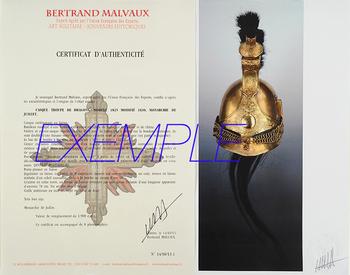
Next update Friday, december 12 at 13:30 PM
FOR ALL PURCHASES, PAYMENT IN MULTIPLE CHECKS POSSIBLE
bertrand.malvaux@wanadoo.fr 06 07 75 74 63
SHIPPING COSTS
Shipping costs are calculated only once per order for one or more items, all shipments are sent via registered mail, as this is the only way to have proof of dispatch and receipt.
For parcels whose value cannot be insured by the Post, shipments are entrusted to DHL or Fedex with real value insured, the service is of high quality but the cost is higher.
RETURN POLICY
Items can be returned within 8 days of receipt. They must be returned by registered mail at the sender's expense, in their original packaging, and in their original condition.
AUTHENTICITY
The selection of items offered on this site allows me to guarantee the authenticity of each piece described here, all items offered are guaranteed to be period and authentic, unless otherwise noted or restricted in the description.
An authenticity certificate of the item including the description published on the site, the period, the sale price, accompanied by one or more color photographs is automatically provided for any item priced over 130 euros. Below this price, each certificate is charged 5 euros.
Only items sold by me are subject to an authenticity certificate, I do not provide any expert reports for items sold by third parties (colleagues or collectors).
FOR ALL PURCHASES, PAYMENT IN MULTIPLE CHECKS POSSIBLE
bertrand.malvaux@wanadoo.fr 06 07 75 74 63
An authenticity certificate of the item including the description published on the site, the period, the sale price, accompanied by one or more color photographs is automatically provided for any item priced over 130 euros. Below this price, each certificate is charged 5 euros.
Only items sold by me are subject to an authenticity certificate, I do not provide any expert reports for items sold by third parties (colleagues or collectors).
